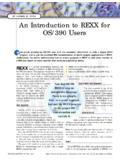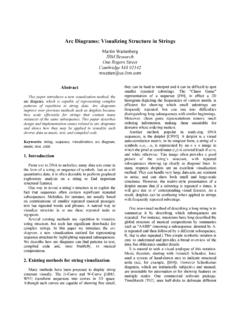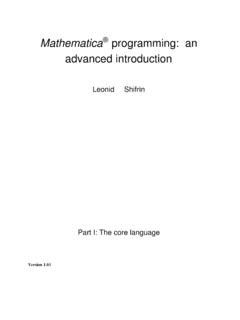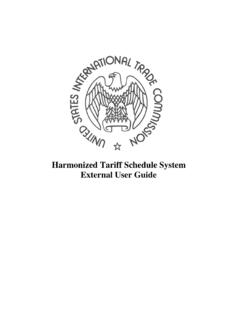Transcription of A Versatile Record Linkage Method by Term …
1 A Versatile Record Linkage Method by TermMatching Model Using CRFQ uang Minh Vu, Atsuhiro Takasu, and Jun AdachiNational Insitute of Informatics, Tokyo 101-8430, solve the problem of Record Linkage between databaseswhere Record fields are mixed and permuted in different ways. The so-lution Method uses a conditional random fields model to find matchingterms in Record pairs and uses matching terms in the duplicate detec-tion process. Although records with permuted fields may have partlyreordered terms, our Method can still utilize local orders of terms forfinding matching terms. We carried out experiments on several well-known data sets in Record Linkage research, and our Method showed itsadvantages on most of the data sets. We also did experiments on a syn-thetic data set, in which records combined fields in random order, andverified that it could handle even this data IntroductionInformation on the web is growing at an explosive rate [10], and informationabout an object may appear in several places.
2 To retrieve such information ef-fectively, we need to merge all the spread out information on the same of the previous studies have dealt with collecting information about com-panies, people, etc. [16,1,3]. In this study, we tried to collect information aboutjournal papers from different data resources. An application is extraction of in-formation about papers from publication lists posted on the web and matchingthem with records in research paper databases. Since databases and publica-tion lists are different resources, the field orders and field permutations mightbe different; this makes Linkage a more challenging task. We devised a versatilemethod for linking records that can work well with field-reordered of the previous studies on Record Linkage targeted databases with recordsthat have similar field orders [4,13,8].
3 For example, some focused on field seg-mentation records, where two sets of fields in two databases are the same. Themethods that were developed in these studies work well with long string combi-nations from the same set of fields and when the fields are combined in the sameorder. Hereafter, we call such field segmentation records and field combinationstring recordssegmentation recordsandstring records, for short. For these kindsof records, the previous studies built matching models based on the string editdistance to find common information between two records and to find differ-ent information that is inserted/deleted to/from one Record . Although methodsbased on the string edit distance are effective for records with the same Bhowmick, J. K ung, and R. Wagner (Eds.): DEXA 2009, LNCS 5690, pp. 547 560, Springer-Verlag Berlin Heidelberg Vu, A.
4 Takasu, and J. Adachiorder, they are of limited benefit when the records are from different databasesand have different field orders. For example, in these two records: Four SeasonsGrill Room, 854 Seventh Ave., New York City and 854 Seventh Ave., NewYork City, Four Seasons Gril l Room , the common text Four Seasons GrillRoom appear at the head of one Record but at the tail of the other Record , andthe string edit distance Method will regard this text as being deleted from bothrecords. This fault may degrade the duplicate detection is another Record Linkage Method that builds bags of words for recordsandmeasurestheweightsofcommonterm s [4]. This Method can find recordpairs that have different field orders, but it neglects the term orders in a , it is difficult to detect overlapping phrases, and this drawback maydegrade the duplicate detection detect duplications in records that have different field orders, we tried tofind matching information at the term level and combine the matching informa-tion for the duplicate detection process.
5 Our approach uses a labeling Method tofind matching terms. Terms in one Record are used as labels for matching termsin another Record . We solve this labeling problem by using a conditional randomfields (CRF)[11,15] model. CRF is usually used to solve the sequence labelingproblem. For example, we applied CRF to bibliographic information extractionfrom title pages of academic articles where term sequences appearing in titlepages are labeled with bibliographic components [14]. Unlike standard CRF ap-plications including our previous study [14], here we use CRF to align terms ina pair of bibliographic records. Our way of CRF application is similar to thestudy [13], where CRF was used to measure the costs of a learnable string editdistance. However, their model sufferswhen the term orders of the comparedstrings are different.
6 Our CRF model is analogous to a CRF model which alignsterms in machine translation [5]. Our model detects reordered terms in differentrecords, while their model [5] detects terms having the same meaning in rest of this paper is organized as follows. Section 2 summarizes the relatedstudies on Record Linkage . Section 3 presents our term matching model that isbased on the CRF model and our duplicate detection classifier that is based onthe support vector machine (SVM) Method [7]. Section 4 shows experimentalresults on several well-known data sets and compares them with the results ofprevious research. Section 5 discusses the advantages of our model and comparesit with other CRF models in other applications so that the reader can betterunderstand the characteristics of our approach. Finally, Section 6 concludes Related WorkIn [9,4,13], the string edit distance Method is used to detect duplicate parts anddifferent parts of two records.
7 The authorscarefully considerededit operations,so that they could be used to recognize important text changes that help todifferentiate two distinct records. To recognize important text changes, theyused an SVM model in [4] and a CRF model in [13]. However, these approachesA Versatile Record Linkage Method by Term matching Model Using CRF549 Record XFourSeasonsGrillRoom,854 SeventhAv enu e,NewYo r kCityRecord YFourSeasonsGrillRoom854 SeventhAv enu e,NewYo r kCity,12 3 4 56 78910 Position of terms in Record X89105671234 Mapping LFig. of term matching using the proposed modelhave trouble handling records with different field orders. If the fields of the tworecords are not aligned or their field combinations are in different orders, thereare no reasonable edit operations to transform one Record into another [4], the authors also used bags of words of records to find improved the term frequency-inversedocument frequency (tf-idf) weightingscheme [2,12] in the traditional vector space model by using a model to learnimportant words that are strongly related to a specific database.
8 This methodcan be applied to records that have different data field orders. However, since thebag-of-words approach ignores term orders in a string, it can not recognize terms consecutiveness, and therefore, it can not utilize matching phrases in Application of CRF to Term matching ProblemLet us define the notations used in this paper. For a sequenceX,|X|denote thelength of the sequence. For a setSand integerl,Sldenotes a set of sequences ofelements ofSwhose length isl. We detect identical Record pairs by performingthe following two mapping: map terms in a pair of records using CRF, : decide the identity of the pair based on the term mapping us consider the pair of records in Section 2. Figure 1 shows a term mappingbetween the pair of recordsXandY. Note that the mapping does not preservethe order of Record is denoted by a sequenceX=(x1,x2.)
9 ,xn), where each elementxirepresents a term in the Record . For a segmentation Record , we encode the fieldtype and field ID together with the spelling of the term in order to utilize them asfeatures in CRF. Therefore, each termxicontains three pieces of information:xi=(xspelli,xfieldi,xidi), wherexspelliis the term spelling,xfielditype of fieldwherexiexists, andxidithe field ID. For example, the field type of the first tothird terms of the recordXin Fig. 1 is restaurant name, whereas the field Vu, A. Takasu, and J. Adachiof the 8th to the 10th terms is city name. Records often contain multiple valuesfor a field such as the authors of the article. The field ID is used to discriminatefields of the same type. For example, regarding a termxifor the first authorand a termxjfor the second author, their field types are the same, but theirfield IDs are different: ,xfieldi=xfieldjandxidi =xidj.
10 Since a string recorddoes not have any field information, we introduce an imaginary field typestringand assign it to all terms, , xi=(xspelli,string,1) for anyith term in a stringrecord, where the field ID of all terms is denote a mapping between terms in recordXandYas a listm (m1,m2, ,m|Y|) of positions of terms inXwheremidenotes the position ofthe term inXthat is mapped to theith term inY. For example, the mappingin Fig. 1 is represented with (8,9,10,5,6,7,1,2,3,4) by which, for instance, thefirst term New in recordYis mapped to the 8th term New in handle the term mapping by using a linear chain CRF model, for each pairof records (X,Y), we use the terms in one Record as labels and assign one ofthem to each term in the other Record . Formally, we initially set a null position0 that means that there is no corresponding term (X,Y), we useLX {0,1,2, ,|X|}as the set of labels for terms term mapping between a recordXandYis defined as a label sequencem L|Y| in the linear chain CRF model, we assume that the mapping of termyiis determined by the mapping ofyi 1andyiitself.







